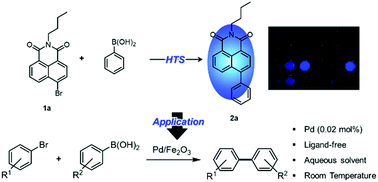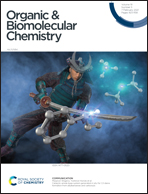Ligand-free Suzuki–Miyaura cross-coupling with low Pd content: rapid development by a fluorescence-based high-throughput screening method†
Abstract
Suzuki–Miyaura (SM) cross-coupling is one of the most effective strategies for carbon–carbon bond formation, but previous methods have several drawbacks, such as the requirement of complicated ligands, toxic organic solvents, and high-content-Pd catalysts. Thus, in this study, a highly efficient SM cross-coupling was developed using metal oxide catalysts: 0.02 mol% Pd, aqueous solvent, no ligand, and room temperature. Metal oxides containing low Pd content (ppm scale) were prepared by a simple co-precipitation method and used as a catalyst for the SM reaction. A fluorescence-based high-throughput screening (HTS) method was developed for the rapid evaluation of catalytic activity and reaction conditions. Among the various metal oxides, Pd/Fe2O3 showed the highest activity for the SM reaction. After further optimization by HTS, various biaryl compounds were obtained under optimal conditions: Pd/Fe2O3 (0.02 mol% Pd) in aqueous ethanol at mild temperature without any ligands.

- This article is part of the themed collection: Catalysis & biocatalysis in OBC


 Please wait while we load your content...
Please wait while we load your content...